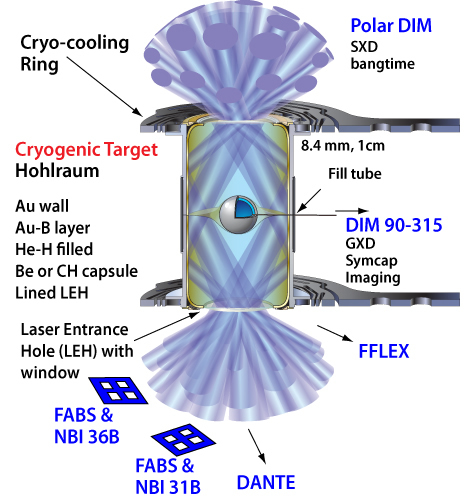Hohlraum Energetics
Platform Purpose
The hohlraum energetics emulator experiments conducted by the Hohlraum Integrated Experimental Team (IET) were the first cryogenic experiments in a series of sub-campaigns with the goal of establishing the hohlraum target for ignition experiments that began in 2010. The experiments require up to 192 beams smoothed with continuous phase plates (CPPs), smoothing by spectral dispersion (SSD), and polarization smoothing (PS). A variety of hohlraum targets, including cryogenic hohlraums and hohlraums filled with a H-He gas mixture, are used.
These shots are designed to create hohlraum plasmas that emulate the plasma density and temperature conditions in an ignition hohlraum. Because the scale of the target is slightly reduced compared to a full ignition target, achieving the same laser-plasma interaction gain values would require a higher laser intensity than used in these hohlraum emulator shots. In the intensity scaling sub-campaign, shots use higher intensities in the interaction beams (quads 31B and 36B with special scale 0.7 continuous phase plates) and establish the laser backscattering measurements at the closest possible gain to an ignition hohlraum. The goal of the emulator shots is to create well-characterized hohlraum plasmas with relevant densities and temperatures with heater beams that produce very small backscatter. The measurements of the radiation temperature, the laser power and energy, and small backscatter values then allow benchmarking the radiation hydrodynamic modeling for cryogenic hohlraums on NIF. In addition, a spectral measurement of SBS and SRS with the Full Aperture Backscatter System (FABS) and Near Backscatter Imager (NBI) test if the desired plasma conditions have been achieved. The emulator target is then used to establish the maximum viable laser intensity and select the hohlraum radiation temperature for ignition.
Laser and Target Configurations
The laser and target configurations for this platform are summarized below:
| Target | # beams | Laser energy/Pulse width |
|---|---|---|
| Au hohlraum | 96 | 350 kJ/ 2 nsec |
| Au:B hohlraum | 96 | 350 kJ/ 2 nsec |
| Au hohlraum, cryogenic, H-He gas fill | 96 | 230 kJ, 4-6 nsec shaped pulse |
| Au hohlraums | 192 | 600 kJ, 2 nsec |
| U hohlraums | 192 | 600 kJ, 2nsec |
| Au:B hohlraum | 192 | 1 MJ, 11 nsec shaped pulse |
Hohlraums will generally be of two sizes, "Scale 0.7" and "Scale 0.9." Dimensions for these hohlraums are summarized below:
| Target | Hohlraum Length | Hohlraum width | Laser Entrance Hole (LEH) |
|---|---|---|---|
| Scale 0.7 | 6.4 mm | 3.6 mm | 2.6 mm |
| Scale 0.9 | 8.4 mm | 4.6 mm | 2.9 mm |
The laser employs Polarization Smoothing and Smoothing by Spectral Dispersion, with a nominal bandwidth of 60 Ghz for the latter. A 2-color wavelength detuning, typically 0.5Å between inner and outer cones also is required. Additional detailed modifications to the laser and target will be made to suit the needs of particular experiments; please see below for further information.
Figure 1 shows a typical configuration for these experiments.
Diagnostic Configuration
Standard diagnostics for this platform and their location (elevation, azimuth) are provided below. See Chamber Geometry and Diagnostics for additional information.
| Diagnostic | Location |
|---|---|
| Dante-1 | Fixed (143-274) |
| FABS/NBI | Q31B, Q36B |
| FFLEX | Fixed (90-110) |
| GXD | DIM 90-315 |
| SXD/GXD | Polar 0-0 |
| SXI, Top/Bottom | Fixed ((18-123),(161-326)) |

For further information on scientific opportunities at the NIF, please contact:
User Office
PHONE: (925) 422-2179
nifuseroffice@llnl.gov



